Backpacking with dogs: Dog backpacking is a fun and rewarding activity for both you and your furry friend. It allows you to bond with your dog while enjoying the great outdoors.
However, before embarking on a backpacking trip with your dog, it’s important to plan and prepare thoroughly. To start, finding dog-friendly trails is crucial.
Some backpacking trails may not allow dogs or may have restrictions, so researching beforehand can save you time and hassle. Once you’ve found a suitable trail.
It’s time to pack the right gear. A dog backpack can be a lifesaver during backpacking trips as it allows your pet to carry their own food, water, and gear.
Look for lightweight dog packs that won’t weigh down your furry companion. Ultralight foam sleeping pads are also great options to reduce weight without compromising comfort.
When packing for backpacking trips with dogs, don’t forget about lightweight treats in bags or packs to keep them energized during day hikes or car camping trips.
Make sure to bring enough water for both you and your pet. Planning ahead also means being prepared for emergencies.
Pack a first aid kit specifically designed for dogs that includes items such as tweezers (for removing ticks), gauze pads (for injuries), and antiseptic wipes (to clean wounds).
While on the trail, make sure to follow Leave No Trace principles by packing out all waste (including that of your furry friend) and leaving nature undisturbed.
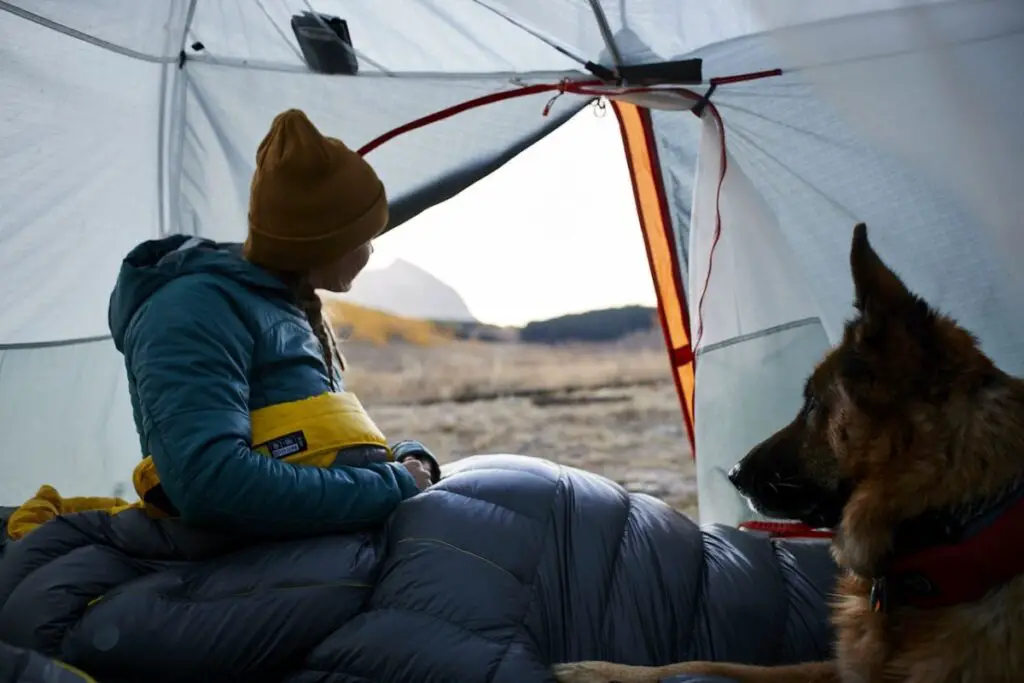
Plan Ahead: Choosing the Right Trail and Gear for Your Dog
Research the trail beforehand to ensure it is dog-friendly and suitable for your furry companion.
Before embarking on a backpacking trip with your canine friend, it’s essential to do some research on the trail you plan to take.
Not all trails are dog-friendly, so make sure you check ahead of time. You can find this information online or by contacting local park rangers.
Knowing the rules and regulations of the area will help you avoid any potential issues during your hike.
Moreover, picking a trail that matches your dog’s fitness level and experience in hiking is crucial.
If your dog is not used to long hikes or has never been on one before, start with a shorter and less challenging trail.
Gradually increase the difficulty level as they become more comfortable with hiking.
Gear up your dog with a well-fitted harness, collar with ID tags, leash, and booties (if necessary).
Equipping your furry companion with proper gear is vital for their safety and comfort during backpacking trips.
A well-fitted harness ensures that they don’t slip out of it while hiking, while a collar with ID tags helps identify them if they get lost.
A leash is also crucial when hiking in areas where there may be other hikers or wildlife around. It keeps them under control and prevents any unwanted incidents from happening.
If you’re planning on taking your dog through rough terrain or hot pavement, consider investing in booties to protect their paws from injury or burns.
Create a checklist of essential items for your dog such as food, water, first aid kit, waste bags, and toys.
Packing everything that your furry friend needs ensures that they remain healthy throughout the trip.
Some key items include food (with extra servings), water (enough for both you and them).
Waste bags (to clean up after them), first aid kit (for emergencies), toys (to keep them entertained), and any medication they may need.
It’s also important to check if there are water sources along the trail or if you need to bring extra. Dehydration can be a severe problem for dogs, especially during hot weather.
Always prioritize your dog’s safety and comfort throughout the backpacking trip. While hiking with your furry companion, always prioritize their safety and comfort.
Keep an eye on them at all times, especially in areas with steep cliffs or dangerous wildlife. Be mindful of their behavior and take breaks when needed.
Avoid letting your dog eat anything they find on the trail as it could be poisonous or harmful to their health.
Always carry enough food for them so that they don’t have to resort to eating unknown substances.
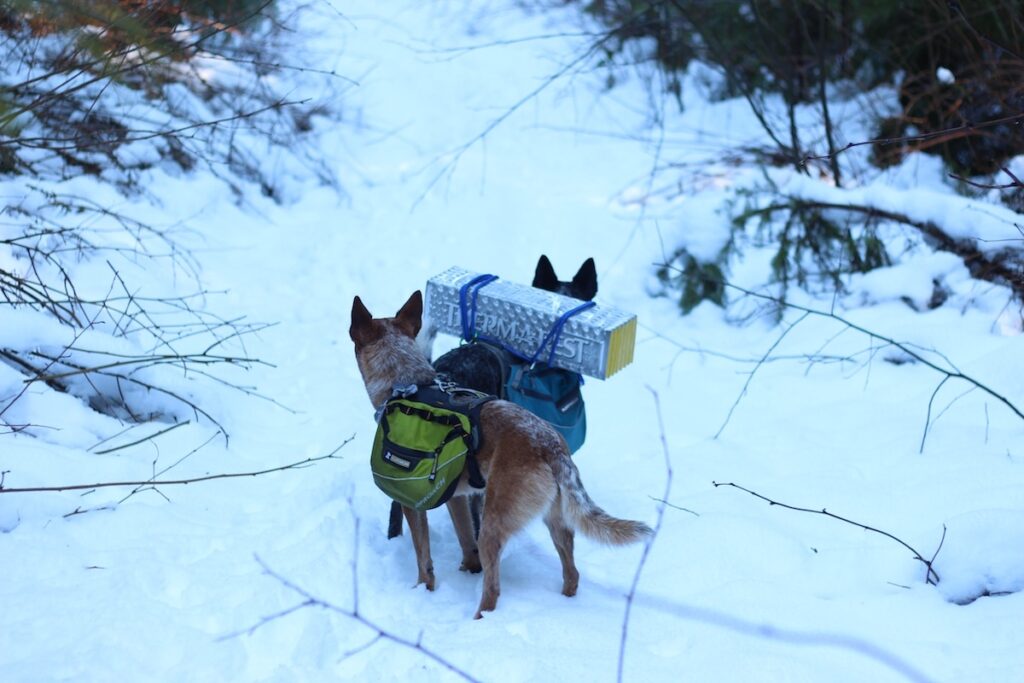
Keep Your Dog Under Control: Training and Obedience Tips
When you go backpacking with your dog, it’s important to make sure they are well-behaved and obedient.
You don’t want your furry friend running off into the wilderness or causing trouble with other hikers or their pets.
Before you hit the trail, make sure your dog is trained to come when called, walk calmly on a leash, and follow basic commands like “sit” and “stay.”
Use Positive Reinforcement Techniques with Dog Treats to Train Your Dog to Follow Commands
Training your dog to follow commands is essential for backpacking trips.
Positive reinforcement techniques, such as using dog treats, can be highly effective in training your dog to behave appropriately on the trail.
When your dog follows a command correctly, reward them with a treat. This will encourage them to repeat the behavior and reinforce good habits.
It’s important to remember that dogs respond best to positive reinforcement, so avoid punishing or scolding them if they do not follow a command correctly.
Instead, redirect their attention and try again. Consistency is key so be sure to practice regularly and use the same commands consistently.
Keep Your Dog on a Leash at All Times
Keeping your dog on a leash at all times is crucial for their safety and the safety of others on the trail.
Even if your dog is well-behaved off-leash, unexpected situations can arise that may cause them to run off or become aggressive towards other dogs or hikers.
Invest in a sturdy leash that is appropriate for the size of your dog and make sure it is securely attached before hitting the trail.
Avoid retractable leashes as they can pose a risk of entanglement or injury.
Establish Rules for Your Dog Before Hitting the Trail
Before embarking on a backpacking trip with your furry companion, establish some ground rules for their behavior on the trail.
For example, establish designated areas where they are allowed off-leash (such as designated dog runs) and where they must remain leashed at all times.
Practice Obedience Training with Your Dog
Obedience training is an essential part of preparing your dog for backpacking trips. Practice basic obedience commands such as “stay” and “come” regularly before hitting the trail.
It’s important to train your dog before going backpacking with them. Training can help ensure that your dog listens to you in potentially dangerous situations.
For example, if you encounter a wild animal on the trail, your dog may be tempted to chase it.
But if they are trained to stay by your side and come when called, you can prevent them from getting hurt or lost.
It’s also important to train your dog to walk calmly on a leash, as this will make it easier for you to control them on the trail.
Additionally, teaching your dog basic obedience commands like “sit” and “stay” can be helpful in a variety of situations.
Overall, training your dog before backpacking can make the experience safer and more enjoyable for both you and your furry companion.
Give Your Dog Plenty of Attention and Exercise
Dogs that are happy and well-exercised are more likely to behave appropriately on the trail.
Be sure to give your dog plenty of attention and exercise before embarking on a backpacking trip.
This will help them burn off excess energy and reduce the risk of unwanted behavior.
Consider Enrolling Your Dog in a Formal Obedience Training Program
If you’re struggling to train your dog or want to ensure they are fully prepared for backpacking trips, consider enrolling them in a formal obedience training program.
These programs can be highly effective in teaching dogs basic obedience commands and preparing them for outdoor adventures.
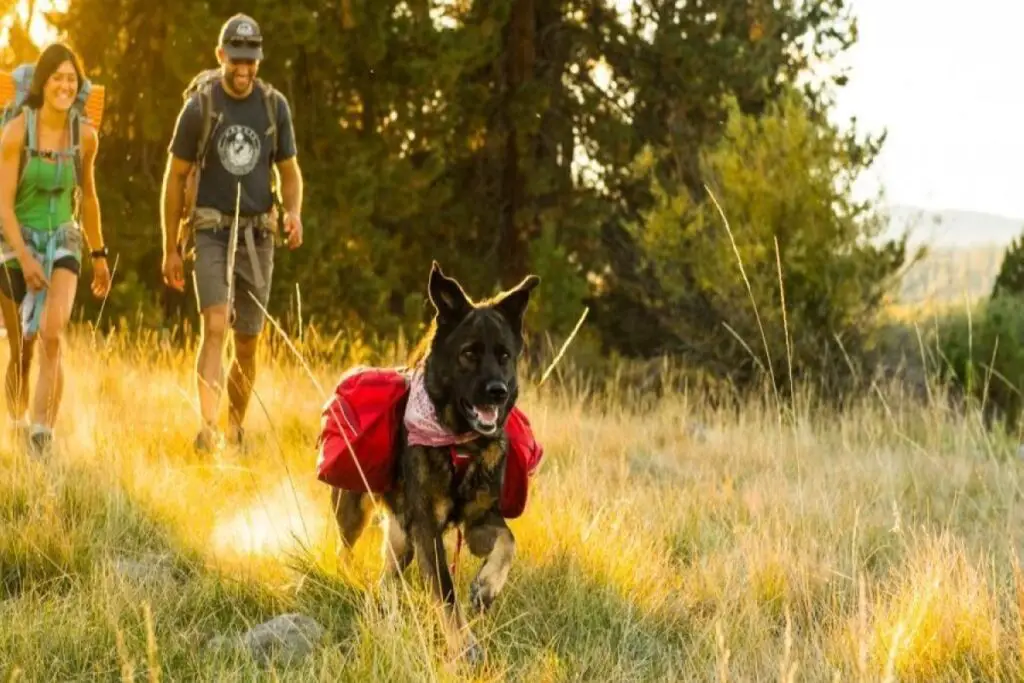
Safety First: Essential First Aid and Emergency Supplies for Your Dog
When you go backpacking with your dog, it’s important to be prepared for any situation. Just like humans, dogs can get injured or sick while out in the wilderness.
That’s why it’s important to bring along a first aid kit specifically designed for dogs.
This should include items such as bandages, antiseptic solution, and tweezers for removing ticks or other debris from your dog’s fur.
Essential First Aid and Emergency Supplies for Your Dog While Backpacking
First aid is an essential component of backpacking with dogs.
Dogs may encounter a variety of hazards while exploring the great outdoors, from cuts and scrapes to snake bites and heat stroke.
Therefore, it’s crucial to pack a well-stocked first aid kit that includes all the necessary supplies to treat your furry friend in case of an emergency.
First Aid Kit Essentials
A basic first aid kit for dogs should include bandages, gauze pads, antiseptic wipes or spray, tweezers, scissors, and a thermometer.
You should pack any necessary medications prescribed by your veterinarian if your dog has a pre-existing medical condition.
A life jacket is also an essential item if you’ll be near water during your trip.
Veterinarian Contact Information
It’s important to carry your veterinarian’s contact information with you in case of an emergency.
If something happens to your dog while on the trail, you need to know how to get in touch with your vet quickly.
You should also have the phone number for the nearest animal hospital or emergency clinic in case of after-hours emergencies.
ID Tags and Vaccinations
Before heading out on a backpacking trip with your dog, make sure they are up-to-date on all necessary vaccinations and preventative treatments recommended by their veterinarian.
Make sure they are wearing ID tags with up-to-date contact information in case they get lost while on the trail.
Pet First Aid Course
Consider taking a pet first aid course before embarking on a backpacking trip with your dog.
These courses teach you how to properly administer first aid to your dog in case of an emergency.
Knowing what steps to take can make all the difference when it comes to saving your pet’s life.
Prioritize Your Dog’s Safety
Above all else, always prioritize your dog’s safety and well-being while backpacking.
Be prepared for any potential emergencies that may arise, and take necessary precautions to prevent them from happening in the first place.
With the right supplies and knowledge, you can ensure that your furry friend stays safe and healthy on your next backpacking adventure.
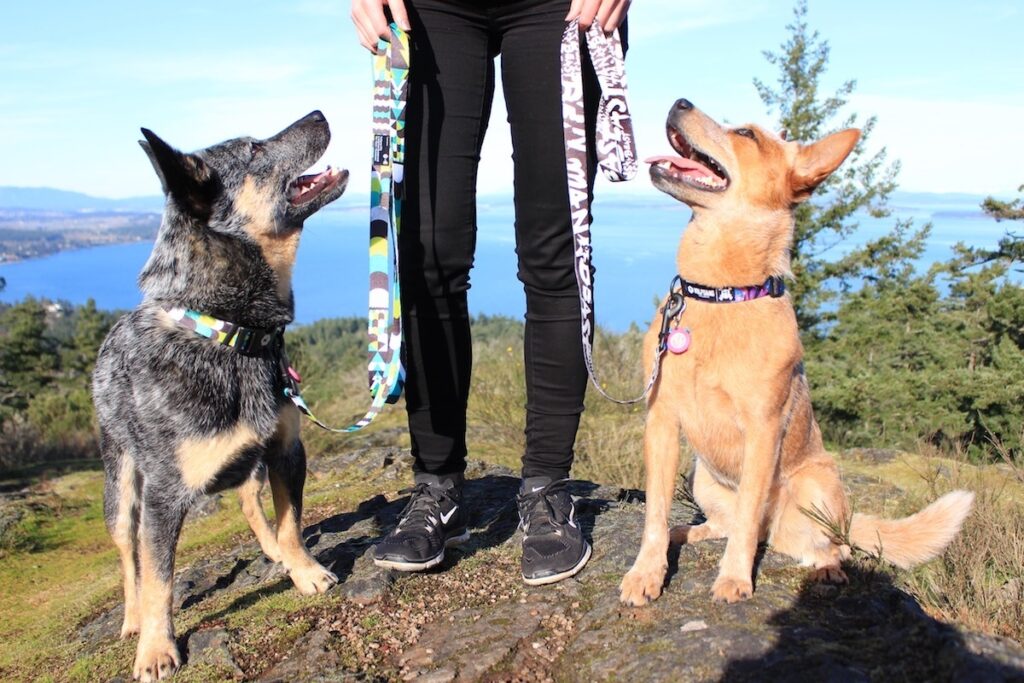
Protecting Your Dog from the Elements: Heat, Cold, and Weather Hazards
Protecting your dog while backpacking is essential to ensure their safety and comfort.
While on the trail, you need to keep an eye out for weather hazards such as heat, cold, and rough terrain that can harm your furry companion.
Here are some tips on how to protect your dog from these elements.
Heat
When hiking in hot weather conditions, it’s crucial to bring enough water for both you and your dog.
Dogs can quickly become dehydrated when exposed to high temperatures. To avoid this, bring a collapsible bowl and enough water for the entire trip.
Consider bringing dog foods that are high in moisture content as they will help keep your pup hydrated throughout the day.
Another way to protect your dog from heat is by keeping them cool during rest breaks.
You can do this by finding a shaded area or setting up a cooling pad for them to lie on. Cooling pads work by absorbing body heat and dissipating it back into the air.
Paw Pads
Rough terrain can cause significant damage to your dog’s paw pads.
To prevent this from happening, use dog booties or apply Ruffwear’s paw balm before starting the hike.
Booties provide protection against sharp rocks, thorns, and other debris that may be present on the trail.
If you prefer not to use booties, applying paw balm is another option.
The balm helps moisturize dry paws while creating a barrier between their pads and rough surfaces.
Dog Goggles
Dogs’ eyes are sensitive to UV rays, wind, and debris that may be present on the trail. Protect their eyes with goggles specifically designed for dogs.
These goggles come in different sizes and shapes depending on your dog’s breed. Apart from protecting their eyes from harmful elements along the trail.
Goggles also provide additional protection against injuries caused by branches and other objects that may come into contact with their eyes.
Cold Water
If you’re planning on swimming with your dog, it’s essential to protect them from cold water.
Dogs can quickly become hypothermic in cold water, which can be life-threatening. To prevent this, use a float coat or jacket to keep them warm while swimming.
Float coats and jackets are designed to provide buoyancy and insulation against the cold water. They come in different sizes and shapes depending on your dog’s breed.
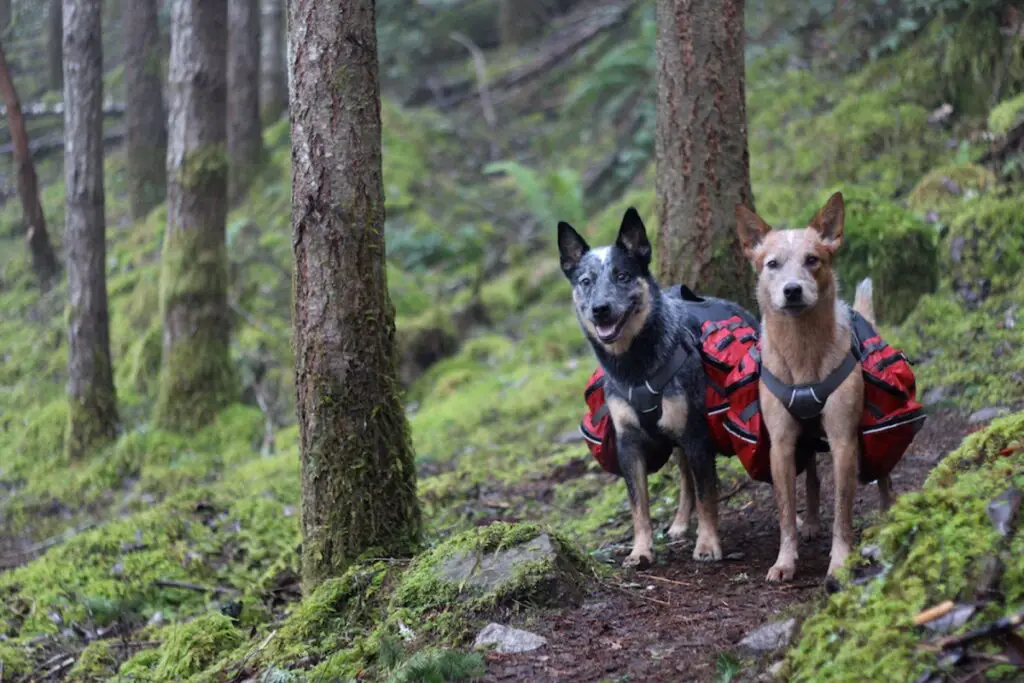
Hydration and Nutrition: How Much Water and Food Does Your Dog Need?
Water is essential for dogs, just as it is for humans. While hiking or backpacking with your furry friend, it’s important to ensure they’re getting enough water to stay hydrated.
Dogs need at least one ounce of water per pound of body weight daily, but even more when hiking or backpacking.
Bringing extra water for your dog is crucial, especially if the trail doesn’t have a reliable water source.
It’s better to err on the side of caution and bring too much water than not enough.
Dehydration can lead to serious health issues in dogs, so make sure they have access to clean drinking water throughout the hike.
Dehydrated food is a great option for backpacking with dogs since it’s lightweight and easy to pack.
However, you need to make sure you bring enough for your dog’s daily needs.
When planning how much food to bring, consider your dog’s activity level and body weight to ensure they’re getting enough calories for the hike.
If you’re unsure about how much food your dog needs while hiking or backpacking, consult with your veterinarian beforehand.
They can provide recommendations based on your dog’s specific needs and requirements.
When packing food for your dog, opt for high-quality options that are nutrient-dense and provide plenty of energy.
Avoid foods that are high in fat or sugar as they can cause digestive issues in some dogs.
In addition to bringing extra water and food, make sure you also pack collapsible bowls or containers for your dog to eat and drink from.
These are lightweight and won’t take up too much space in your backpack.
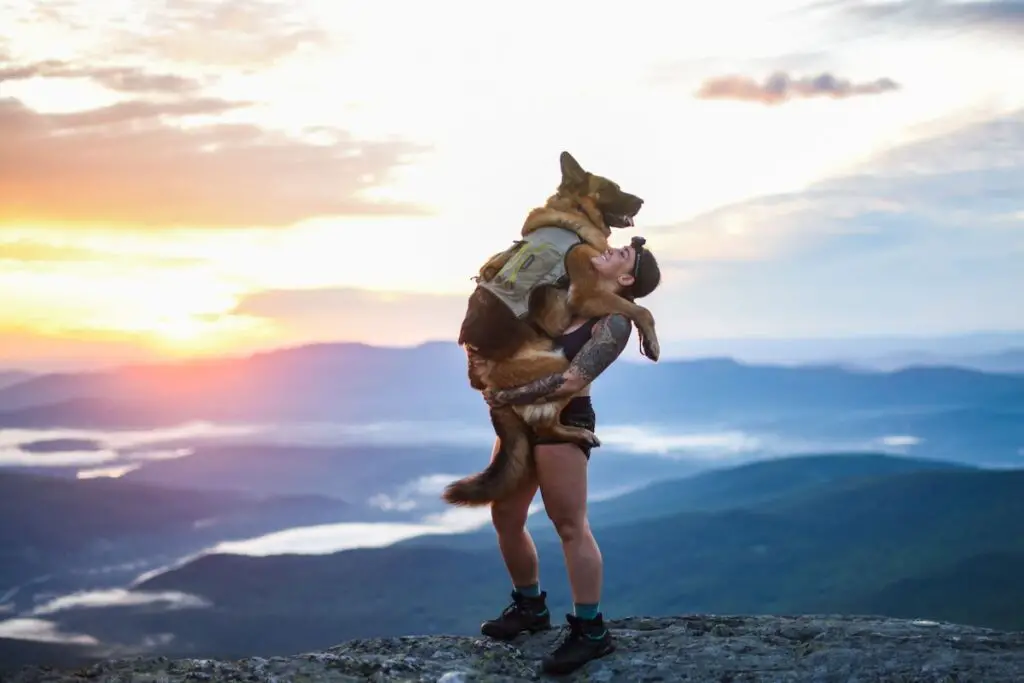
Rest and Shade: Finding Suitable Spots for Your Dog on the Trail
Dogs are great companions to have when you’re backpacking. They love being outdoors and exploring new places just as much as we do.
However, it’s important to remember that dogs need rest and shade during hikes, just like we do.
Here are some tips on finding suitable spots for your dog on the trail.
Bring a Sleeping Pad for Your Dog to Rest On
Just like humans, dogs need a comfortable place to rest after a long day of hiking.
Bringing a sleeping pad for your dog will help keep them off the ground and provide some cushioning.
This can be especially helpful if you’re camping in an area with sharp rocks or other debris that could harm your dog’s paws.
Choose a Suitable Spot for Your Tent Floor
When setting up camp, it’s important to choose a suitable spot for your tent floor. Look for an area that is flat and free from sharp objects that may harm your dog.
It’s also important to keep in mind that dogs may dig holes or try to escape from the tent, so make sure you have a plan in place to prevent this from happening.
Always Keep Your Dog on a Trace
Keeping your dog on a trace is essential when backpacking with them. This will prevent them from wandering off and getting lost or injured.
A trace can also be used as a tie-out point at camp, providing your dog with some freedom while still keeping them safe.
Consider Camping Near Water Sources
When choosing where to camp, consider camping near water sources such as rivers or lakes. This will provide easy access to water for both you and your dog.
The Whyld River is one example of a great water source that many backpackers frequent.
How Do I Know If My Dog Is Getting Too Tired?
It’s important to pay attention to your dog’s behavior while hiking.
Signs that they may be getting too tired include lagging behind, panting excessively, or laying down frequently.
If you notice any of these signs, it’s time to take a break and allow your dog to rest.
Where Should They Sleep?
Your dog can sleep in the tent with you or outside on their sleeping pad.
It’s important to make sure they’re comfortable and warm, especially if temperatures drop at night.
Bringing a blanket or jacket for your dog can help keep them cozy.
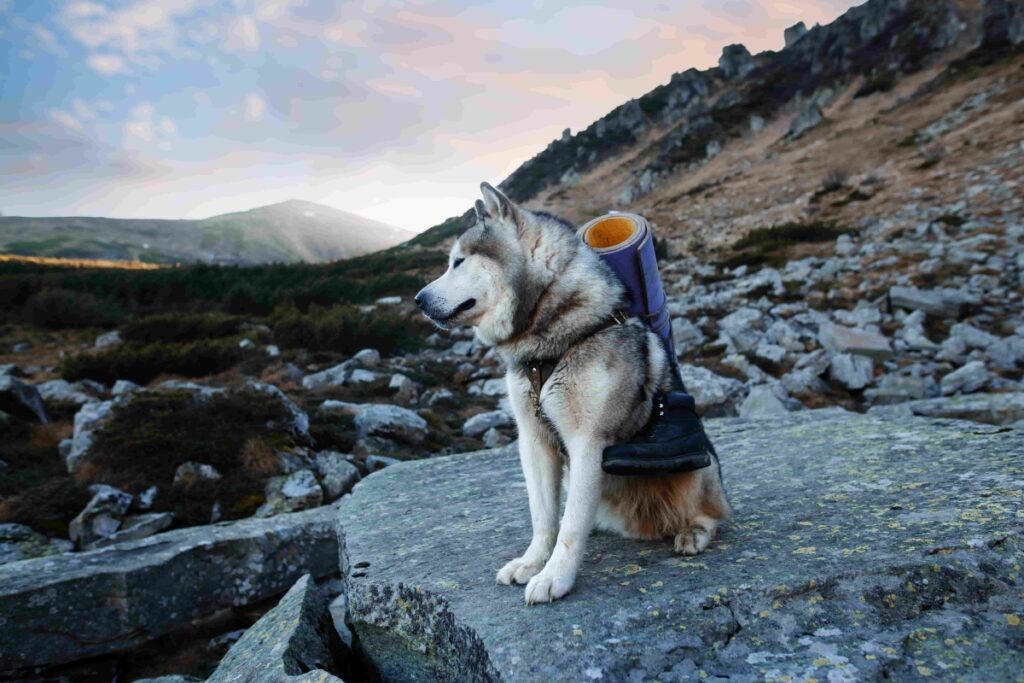
Proper Waste Disposal: Biodegradable Bags and Leave No Trace Principles
When backpacking with dogs, it is essential to practice proper waste disposal. Not only is it necessary for hygiene reasons, but it also helps preserve the environment.
In this section, we will discuss the importance of using biodegradable bags for picking up dog waste and disposing of human waste properly using Leave No Trace principles.
Biodegradable Poop Bags
One of the most significant challenges when hiking with dogs is picking up their poop. It’s not just a matter of cleanliness; it’s also an environmental issue.
Dog feces can carry harmful bacteria that can contaminate water sources and cause harm to wildlife.
That’s why it’s crucial to pack biodegradable poop bags on your backpacking trip.
Biodegradable poop bags are made from materials that break down naturally over time, reducing their impact on the environment.
They are usually made from plant-based materials such as cornstarch or vegetable oil, making them eco-friendly alternatives to traditional plastic bags.
When packing for your trip, make sure you bring enough biodegradable poop bags to last throughout your journey.
Always pick up after your dog and dispose of the bag in a trash receptacle or pack it out with you if there are no facilities available.
Leave No Trace Principles
In addition to picking up after your dog, you must also dispose of human waste properly when backpacking in the wilderness.
The Leave No Trace principles provide guidelines for minimizing our impact on the environment while enjoying outdoor activities.
The first step in practicing Leave No Trace principles is to plan ahead and prepare by bringing all necessary equipment for proper waste disposal.
When nature calls, find a spot at least 200 feet away from water sources or trails and dig a small hole six inches deep using a trowel or stick.
After doing your business, use toilet paper sparingly and pack it out with you in a sealed plastic bag.
Cover the hole with soil and natural materials such as leaves or twigs to help it decompose.
Pack It Out
Whether you’re disposing of dog waste or human waste, always pack it out with you when hiking in the wilderness.
Never leave any trash behind, including biodegradable poop bags and toilet paper.
When packing out your waste, use a designated container that is leak-proof and odor-resistant.
Double-bag your waste to prevent any leaks or spills during transport. Once you reach a proper disposal facility, dispose of the waste appropriately.
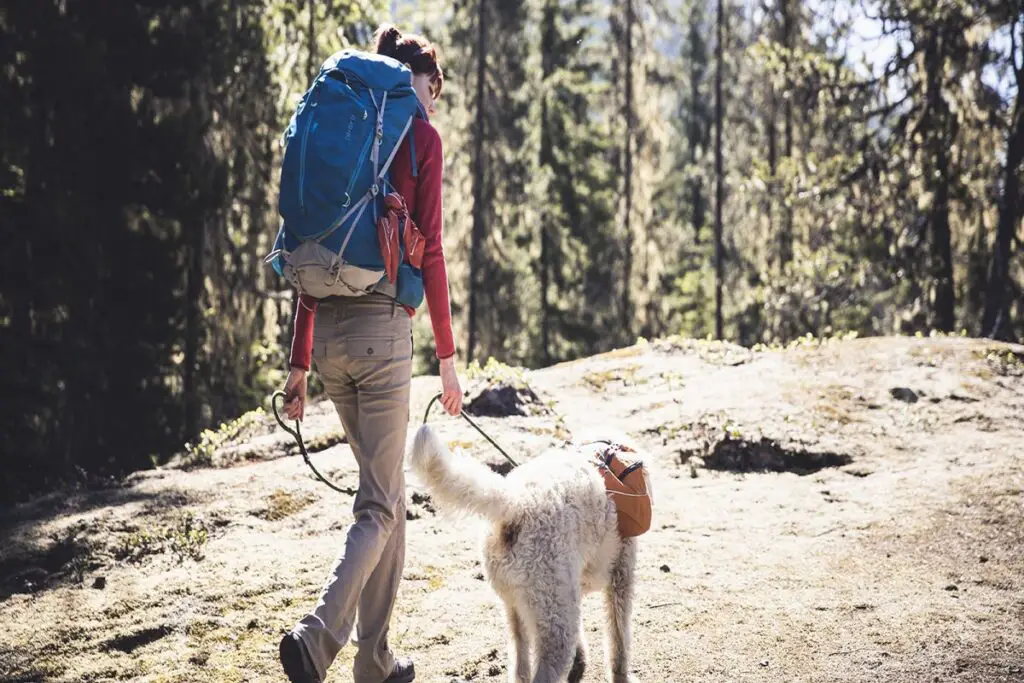
Sharing the Trail: Basic Etiquette and Rules for Hiking with a Dog
When hiking with your dog, it’s important to be respectful of other hikers and their pets.
Always keep your dog on a leash and under control, especially when passing other hikers.
If your dog is prone to barking or jumping on others, consider using a muzzle or keeping them close to you until the other hiker has passed.
Additionally, always clean up after your dog and pack out any waste.
Remember to also check local regulations and rules before heading out on the trail with your furry friend.
Keeping Your Dog on a Leash
When hitting the trails with your furry friend, it’s important to keep them on a leash at all times.
Not only is it required by many parks and hiking areas, but it also ensures the safety of other hikers and their dogs.
Even if your dog is well-behaved and friendly, not everyone may feel comfortable around them.
Plus, keeping your dog leashed can prevent them from running off after wildlife or getting lost in unfamiliar territory.
Yielding to Other Hikers
As you hike with your dog, remember that you’re sharing the trail with others. Always yield to other hikers, especially those without dogs.
This means stepping aside and allowing them to pass safely.
If you come across another dog on the trail, make sure to ask their owner if it’s okay for your dogs to meet before letting them interact.
And if someone asks you to keep your distance from their dog or step aside for any reason, be respectful and comply.
Pack Out All Dog Waste
One of the most important rules of hiking with a dog is packing out all their waste. No one wants to step in dog poop while enjoying nature!
Bring plenty of bags with you on your hike so that you can clean up after your pup as needed.
When disposing of the waste, make sure to put it in designated trash cans or take it home with you if there are no trash cans available.
Avoid Disturbing Wildlife and Other Hikers
While hiking with your furry friend can be fun, make sure they don’t disturb wildlife or other hikers’ experiences.
Keep an eye on your pup at all times and prevent them from chasing after birds or squirrels.
Avoid letting them jump up on strangers or approach other hikers without permission.
Stay on Designated Trails
It’s important to stay on designated trails when hiking with a dog.
Not only does this protect natural habitats and prevent erosion, but it also helps keep your pup safe.
Off-trail hiking can lead to injuries from uneven terrain or encounters with wildlife. Plus, it’s easier to get lost when you’re not following a designated path.
Research Specific Rules and Regulations
Before heading out on your hike, research any specific rules or regulations for hiking with dogs in the area you plan to visit.
Some parks may have restrictions on where dogs are allowed or require certain vaccinations before allowing them on the trails.
By doing your research ahead of time, you can ensure a safe and enjoyable experience for both you and your furry friend.
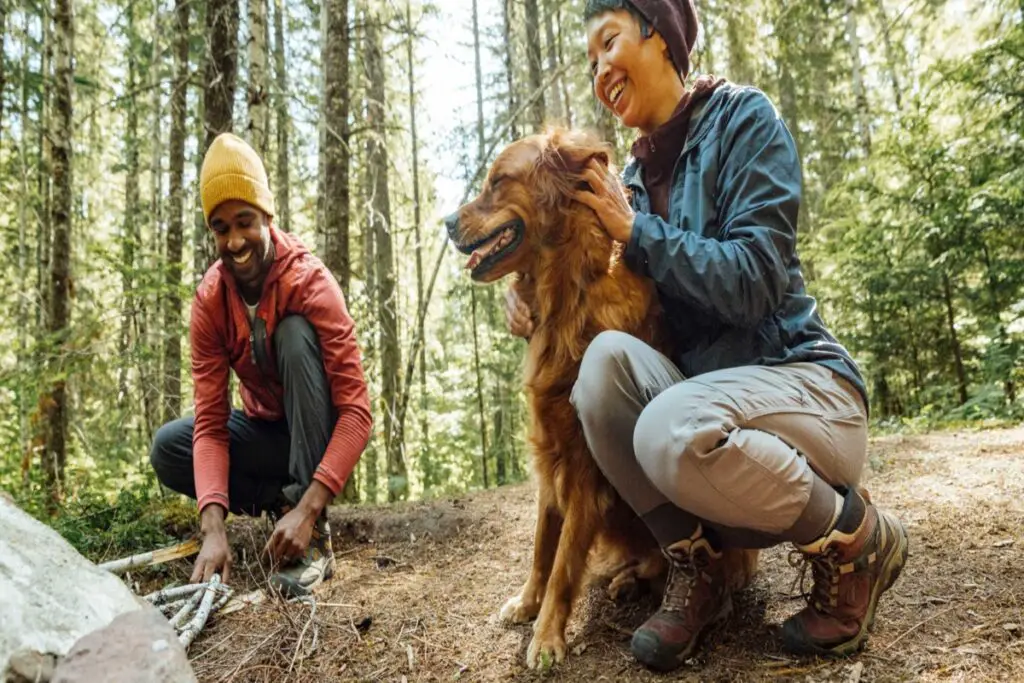
Enjoying the Journey: Making Memories with Your Canine Companion
Canine companions make the best backpacking partners. They are loyal, protective, and always ready for an adventure.
If you’re planning a backpacking trip with your pup, there are a few things to consider to ensure that both of you have a great time.
Dogs come in all shapes and sizes, but they can all be great hikers.
Whether you have a hound or a small pup, taking them on walks regularly will help them keep up with the pace of your trip.
Carrying them when needed also helps them rest and recharge for the next leg of the journey.
Backpacking with your canine companion is not just about getting from point A to point B; it’s about bonding and making memories together.
Dogs love exploring new trails and experiencing new smells. You’ll get to see their excitement as they discover new sights and sounds along the way.
Plus, having your furry friend by your side makes everything more enjoyable.
When planning an extended backpacking trip with your dog, it’s essential to pack high-quality food that meets their nutritional needs.
Honest Kitchen provides excellent dog food options that are perfect for long trips throughout the year.
Their dehydrated meals are easy to prepare and packed with nutrients that will keep your pup healthy and energized throughout the journey.
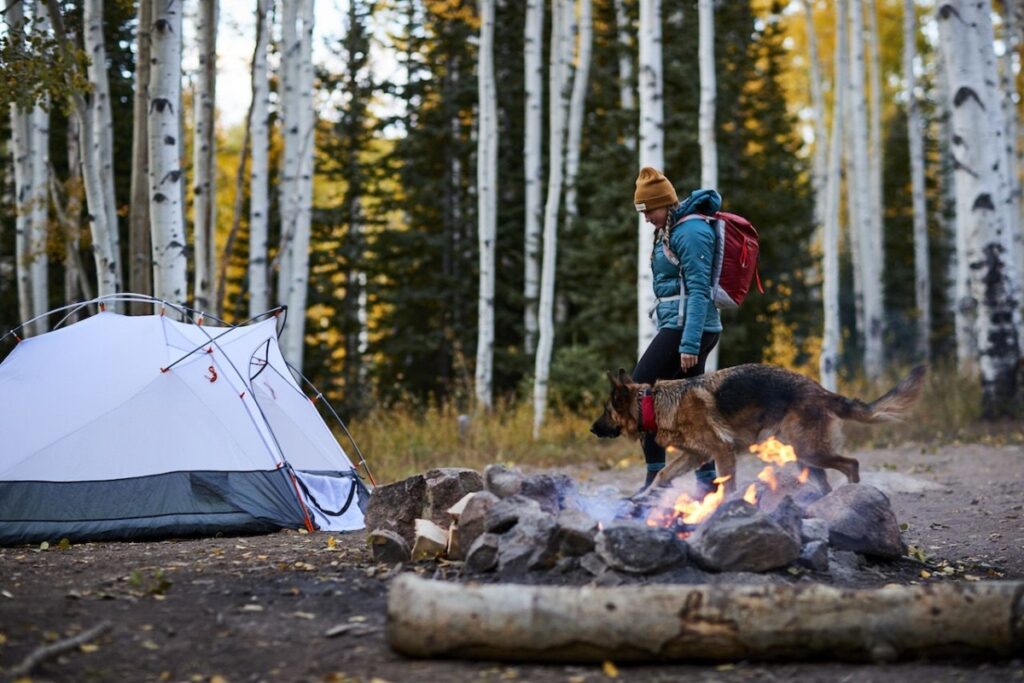
FAQ
1. Best backpacking dog breeds?
There are many dog breeds that are great for backpacking! Some popular ones include Labrador Retrievers, Australian Shepherds, and Border Collies. These dogs are all very active and love to be outdoors. They also have lots of energy, which makes them great hiking companions.
2. Can you backpack with a dog?
Yes, you can backpack with a dog! Dogs love to explore and be outside just as much as we do. However, there are some things you need to consider before you hit the trails with your furry friend. You need to make sure your dog is physically fit enough for the trip.
3. Can you go backpacking with a dog?
Yes, you can go backpacking with your furry friend! But before you hit the trails, there are a few things to keep in mind. First, make sure that your dog is physically fit enough for the trip. You don’t want to overwork them and cause any injuries.
4. How can dog goggles help while hiking?
Dog goggles, also known as doggles, can be very helpful while hiking with your furry friend. They protect your dog’s eyes from the sun, wind, and dust. They can also prevent debris from getting into your dog’s eyes while walking on rough terrain.
5. How do I know if my dog is getting too tired?
It’s important to keep an eye on your dog and watch for signs that they might be getting too tired. If your dog starts to lag behind, pant heavily, or lay down frequently, it could be a sign that they need a break. You can also check their paw pads for any cuts or blisters, which can be a sign of overexertion.
6. How heavy should a dog’s pack be?
It’s important to make sure that your dog’s backpack isn’t too heavy. A good rule of thumb is that a dog’s pack should weigh no more than 10-15% of their body weight. So if your dog weighs 50 pounds, their pack should weigh no more than 5-7.5 pounds.
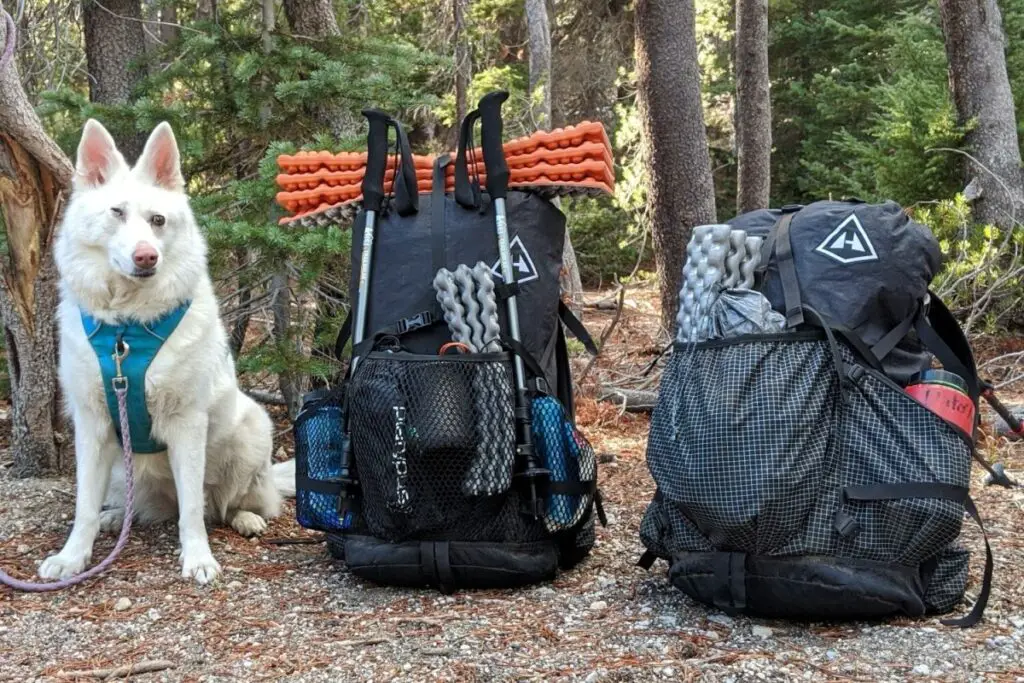
Conclusion
Now that you have all the essential information on backpacking with your furry friend, it’s time to hit the trails and make some unforgettable memories.
With adequate planning and preparation, you can ensure a safe and enjoyable adventure for both you and your dog.
Remember to choose a trail that is suitable for your dog’s fitness level and pack appropriate gear, including first aid supplies, food, and water.
Keep your dog under control by practicing obedience training before hitting the trail.
Always prioritize safety by protecting your dog from weather hazards such as heat or cold. And be prepared with emergency supplies in case of an unexpected situation.
Hydration and nutrition are crucial for your dog’s well-being during a backpacking trip.
Make sure to give them enough water to drink and provide nutritious food to keep their energy levels up.
Rest breaks are also important; find suitable spots for your dog to rest in the shade.
As responsible hikers, it’s our duty to properly dispose of waste using biodegradable bags while following Leave No Trace principles.
Basic etiquette rules should also be followed when sharing the trail with other hikers. Finally, enjoy every moment of this unique experience with your canine companion!
Take plenty of photos together along the way so that you can cherish these memories forever.
Backpacking with dogs can be an incredibly rewarding experience for both pet owners and their furry friends.
With proper planning, training, safety measures, hydration, nutrition, waste disposal practices, hiking etiquette rules followed correctly.
You can create a memorable journey that will last a lifetime. So grab your gear, leash up your pup, hit the trails – adventure awaits!

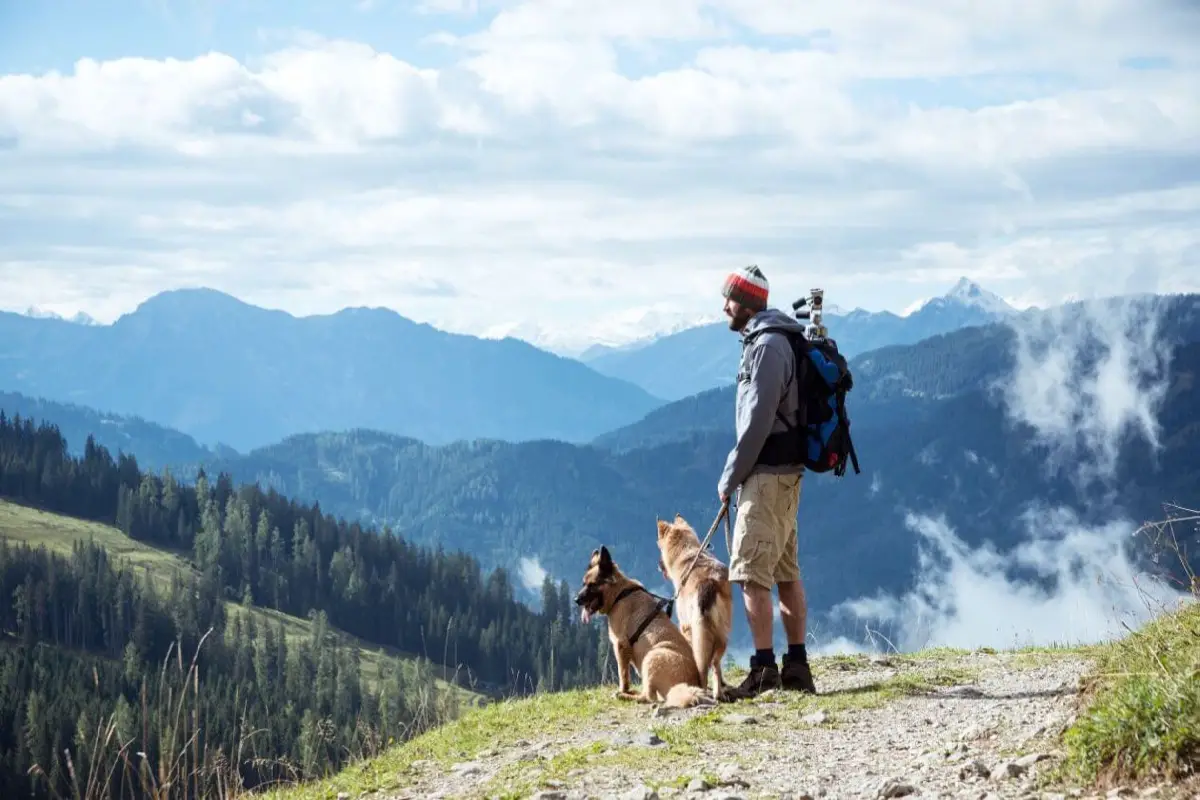







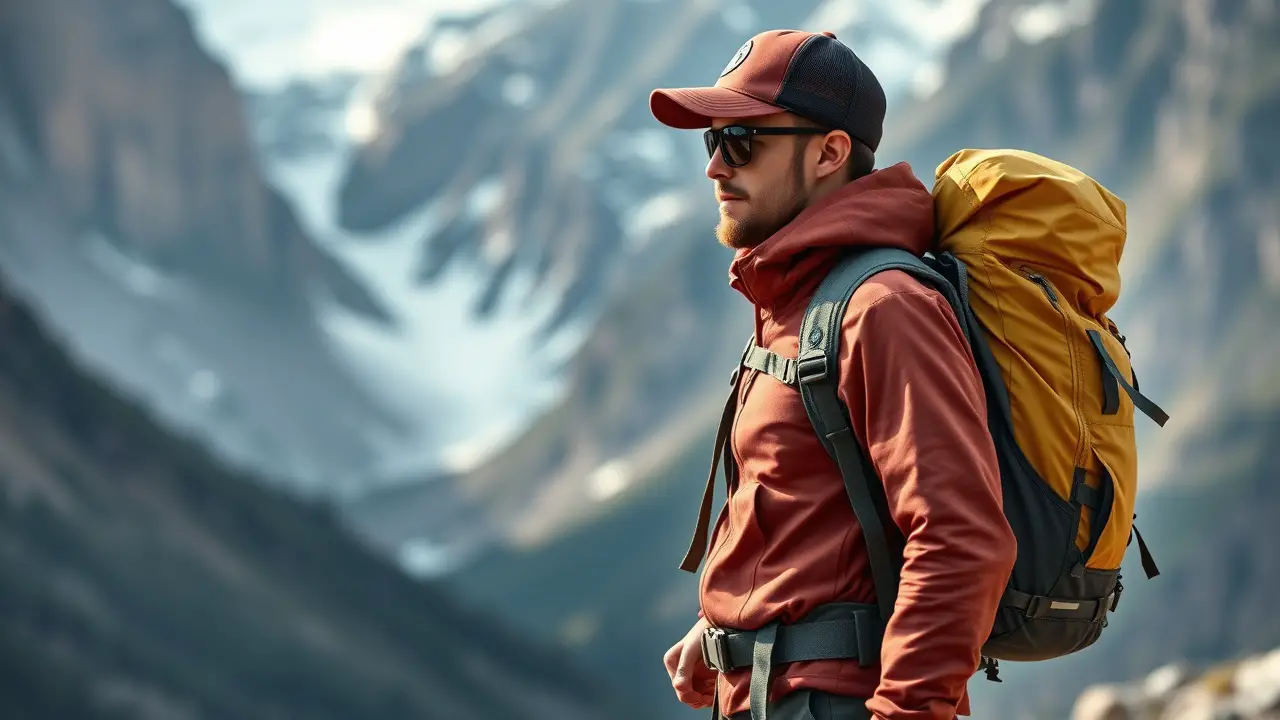
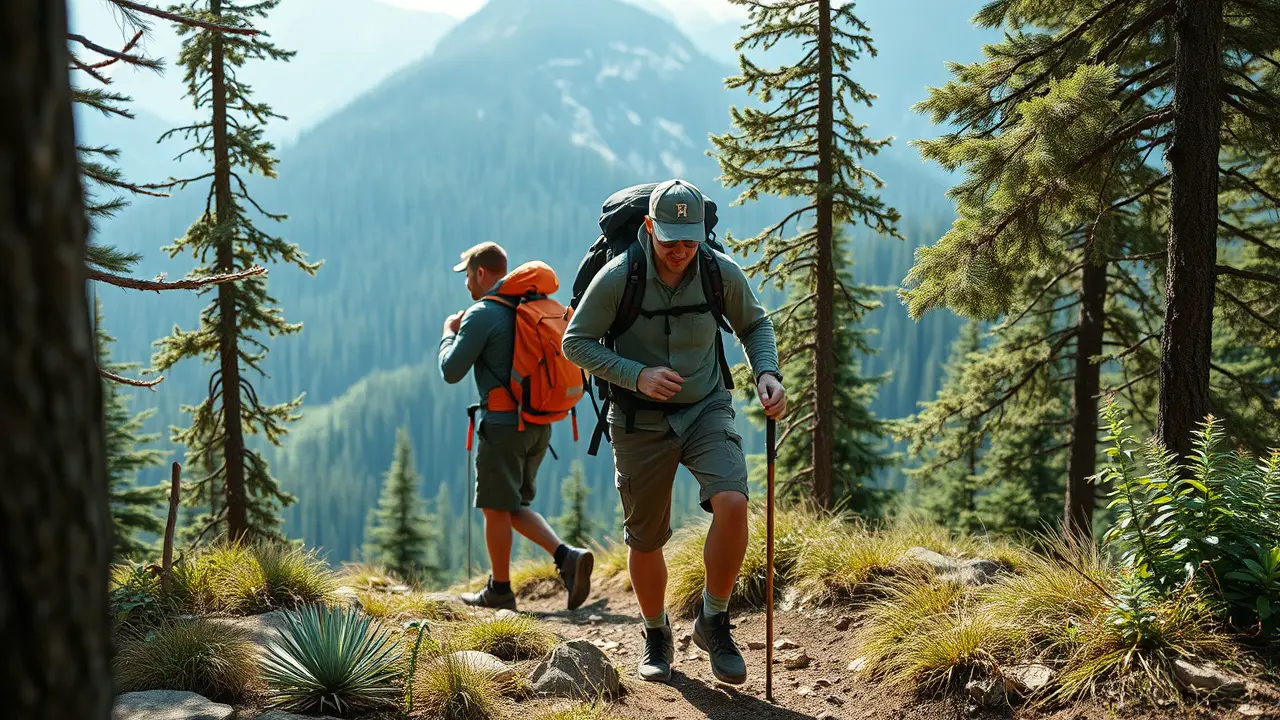
Leave a Reply